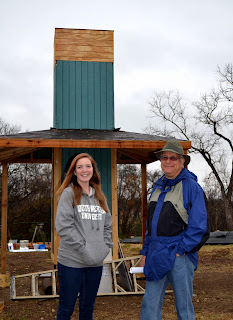Published in the Sun March 16, 2013
 |
| Erin Johnson and Bob Mathis |
Erin Johnson began her
college life in musical theater but was soon disillusioned by the world of
artifice. Drawn instead to the natural
world, she took a job at a wildlife rehabilitation center in Birmingham,
Alabama. Every summer, hundreds of
orphaned baby birds were brought to the center, many of them chimney
swifts. Swifts make fragile nests on the
inside of uncapped chimneys. When the
babies hatch they make a lot of noise begging for food. Hearing a racket in the chimney, many
homeowners would use a broomstick to flush out the noisemakers, breaking the
nest, and causing baby swifts to tumble into the fireplace.
The tiniest chimney swifts
were the hardest ones to save. Barely
hatched before falling from the nest, the baby birds were hairless and their
eyes were not yet open. Erin not only
had to hand feed them every fifteen minutes, but, prior to feeding, she had to
swab the food through the mouth of an adult chimney swift in order to soak up
some of the salivary enzymes essential for the babies to develop a normal
immune system.
The rehabilitation center was
amazingly successful at raising these chicks, and when they were old enough to
fend for themselves, the swifts were released into the wild. Swifts are a vital part of the ecosystem,
keeping flying insects such as mosquitoes under control.
Chimney swifts spend most of
the day in the air catching bugs. They are
unable to sit on a branch or wire and can only perch on vertical surfaces. They attach their nests to the rough inner
surfaces of hollow trees or old-fashioned brick and mortar chimneys. As old chimneys are replaced by modern ones,
the swifts are having difficulty finding proper nesting sites. New chimneys are capped so birds cannot
enter, and are often lined with metal to prevent fires. The slick metal prevents the birds from
perching or attaching nests. The
scarcity of nesting sites has caused a serious decline in population.
When Erin came to
Southwestern University to study animal behavior, she did not lose her interest
in chimney swifts. She knew that
conservationists are replacing lost habitat with towers built especially for
nesting swifts, and she noticed that the vegetable garden on the edge of campus
was a nice location for a chimney swift tower.
Erin applied for a SEED grant (Student Environmental Engagement and
Development) to pay for materials, and then enlisted Bob Mathis, associate vice
president for Facilities and Campus Services, as her general contractor. Erin had already acquired a plan for an ideal
swift habitat from an Austin conservation group, the Driftwood Wildlife
Association. Erin gathered a few of her
friends from the animal behavior society, and Mr. Mathis cajoled some
associates who liked to build things, and the group put together a combination
chimney swift tower/information kiosk.
Chimney swifts winter in
South America, and then come north to breed in the spring. The migration is increasingly difficult
because many of the Central American forests that used to provide sustenance
during the trip have been cut down. Swifts
that successfully complete the trip arrive in our area by the middle of March,
so the tower project was on a strict deadline.
Now that Southwestern University’s first chimney swift tower is
complete, Erin will be watching every day to see if her guests arrive.
No comments:
Post a Comment